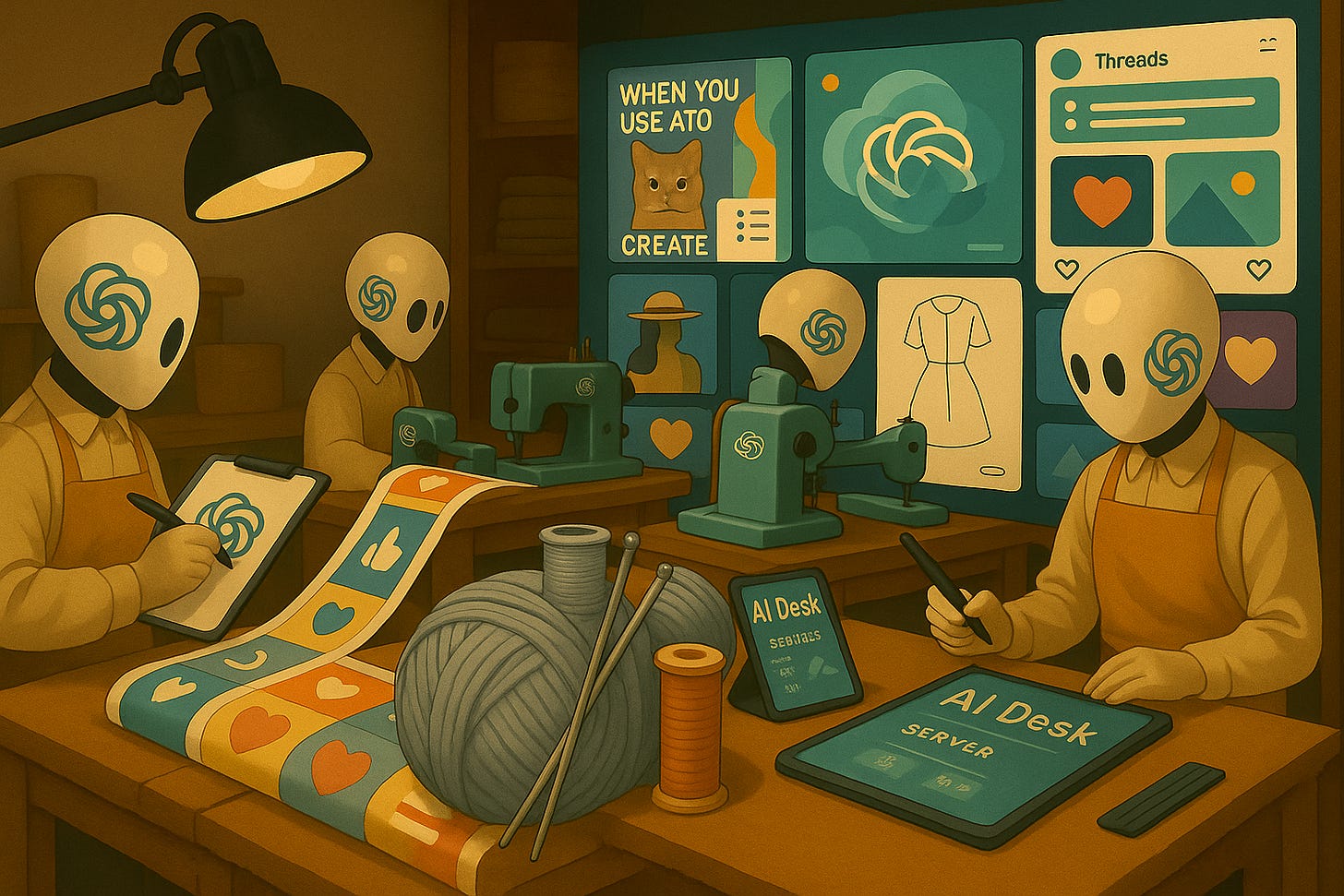🧵 OpenAI’s Own Social Media App — How Much Twitter Will Be in It?
✨ The future of social media has a new driver. Until now, decentralization seemed to shape its path. But 2025 tells a different story: the symbiosis between AI and social platforms is becoming
🕘 Berlin marks 9PM. New York greets the afternoon at 3PM. LA hits high noon at 12PM.
🖐️ Hello everyone, Daniel here — enjoying a few hot summer days. Just as hot as a new trend that’s putting social media back on the Big Tech agenda.
AI-generated content in social apps — that trend had been predicted for 2025 by many. But even I didn’t expect headlines like these: 📌 Elon Musk seems to be giving his Twitter acquisition strategic purpose after all by repositioning X as an AI company. 📌 OpenAI is reportedly working on its own social app. 📌 Telegram wants to integrate Grok.
🧠 What’s Inside This Issue: This week is all about the symbiosis between GenAI and social media. Surprisingly, this wasn’t high on the radar of most social media experts just a few months ago. Now, it’s clearly emerging as a stronger force than even the decentralization movement — and may define the next generation of online interaction.
1️⃣ Weekly Edit
🧪 What to Expect from OpenAI’s Social Media App
OpenAI is working on its own social media platform — and it might be the most AI-native network we’ve seen so far. While the final shape of the app is still undecided (standalone or part of ChatGPT?), early prototypes give us a glimpse into how deeply generative AI could be embedded into social interaction.
🖼️ AI at the Core: At the heart of the concept is a social feed driven by AI-generated content. Users won't just scroll — they’ll co-create. From AI-powered image generation to real-time enhancements for posts, the entire interface is designed to support creative expression with help from ChatGPT.
🎨 Visual First, Powered by Prompts: Expect to see AI-generated visuals take center stage. Users may be able to prompt images directly in-feed, giving rise to a new aesthetic of feed-native, creator-friendly content — where AI is collaborator, not just assistant.
🤖 Beyond Likes: Smarter Suggestions & Conversations: Personalization will likely go further than existing platforms. Content, communities, and even conversation tones could be fine-tuned by AI, giving users a more tailored experience. With ChatGPT integrated, imagine features like AI-assisted chats, post drafting, or real-time discussion moderation.
📊 A Playground for Real-Time AI Training: Just like Meta or X, OpenAI’s platform could serve another purpose: training its own AI models with real-time user data. But this time, the focus is on improving generative and multimodal AI — not ad targeting.
🧠 Creator Culture, Evolved: Early hints suggest a strong focus on creators and new forms of collaborative content: think community-powered prompt pools or AI-supported group storytelling. It’s a sandbox for creativity, wrapped in a social skin.
🧭 Still in the Lab — but Strategically Watched: Sam Altman has confirmed that the project is real — but in flux. No name, no date, and no final format yet. Still, the direction is clear: OpenAI is betting on a social experience enhanced by generative intelligence.
TL;DR: OpenAI’s social platform isn’t just another Twitter clone — it’s aiming to redefine how we create and connect, putting AI at the center of both inspiration and interaction. Whether it launches as a new app or part of ChatGPT, it could shift the way we experience social media from algorithmic consumption to collaborative generation.
2️⃣ Style-Check: Why GenAI and Social Platforms Can’t Get Enough of Each Other
The hottest romance in tech isn’t happening in secret — it’s right there in your feed. In 2025, social media and AI have become inseparable, turning into what many now call tech’s most powerful couple. From X's AI-makeover to OpenAI’s own platform plans, the fusion of algorithm and audience has never been stronger.
📲 Social Apps Run on AI Now: AI doesn’t just support social media anymore — it’s running the show. Whether it’s TikTok’s uncanny recommendations or Instagram’s AI filters and sticker tools, artificial intelligence is what keeps you scrolling, reacting, and coming back. According to Meta, over 20% of Instagram’s feed now comes from AI-suggested sources users don’t even follow — and it works. Engagement is up by 24% since the switch.
🧠 The Engagement Engine: From moderating toxic content to auto-generating backdrops and replies, AI keeps platforms relevant, safe, and sticky. Snapchat’s AI friend, Instagram’s prompt-based tools — these aren’t gimmicks, they’re survival tactics. Social platforms know: if you’re not infused with AI, you’re falling behind.
🤝 Strategic Symbiosis: It’s not just about features — it’s about strategy. When Elon Musk’s xAI acquired X in early 2025, it wasn’t just a rebrand. It was a bet that AI and social data belong together. With 600 million users, X now doubles as both a content platform and a real-time AI training lab. Musk says: “xAI and X’s futures are intertwined.”
📦 Why Social Data is Gold for AI: For AI to improve, it needs human interaction — at scale. That’s where social platforms come in. Musk’s Grok chatbot now lives inside Telegram, thanks to a $300 million deal. Telegram gets smarter replies, xAI gets training data. Even Meta is training its models on public posts. In 2025, data is the fuel, and social apps are the pipeline.
🎯 Why AI Needs Social — and Vice Versa: AI companies crave user scale, diverse input, and live conversations. Social platforms need personalization, moderation, and creative features.
The result is a virtuous loop: AI improves the platform → users engage more → more data trains the AI → AI gets smarter → platform improves. Rinse. Repeat.💬 OpenAI’s Move Says It All: Sam Altman’s rumored social app isn’t a side project — it’s a necessity. Meta and xAI have the user firehoses. If OpenAI wants to stay in the race, it needs its own stage for ChatGPT and DALL·E to perform — and a data pipeline to keep models sharp.
🧵 How To Style IT: The AI-social alliance is no passing trend. It’s a structural shift in how we build, use, and evolve platforms. The feed of the future won’t just show you what’s trending — it will generate it, tailor it, moderate it, and chat with you about it. The result? A more intelligent, more interactive, and yes — more addictive digital world.
3️⃣ Pattern-Check: Stories are out. Reels are in. But why?
We stumbled upon another perspective on why Instagram is pushing Reels so aggressively. And it’s yet another sign that the symbiosis between AI and social media is becoming the hottest trend of the summer. 💥
Alke Martens, Professor of Practical Computer Science with a focus on AI and Ethics, recently explained in a Reel why users should post less in Stories and focus more on Reels instead.
Alke Martens’ Analysis:
We noticed a shift – not just in how creators post, but in what Instagram wants them to post. Rumors suggest a subtle yet powerful algorithm update: Accounts focusing heavily on Stories might now face reduced reach.
Why?
🔍 Unlike Reels, Stories disappear fast and generate only fleeting data. No persistent engagement, no long-term signals for training AI.
📊 Reels, on the other hand, offer:
Evergreen availability in feeds
Facial expressions, movement, voices — prime material for training generative AI
Recurrent feedback loops (likes, comments, shares)
This isn’t just about pushing a format. It’s about shaping the dataset. Instagram's quiet pivot reflects the platform’s evolution: from photo-first, to text slides (Carousels), to full-on AI-friendly short video.
🧠 From a data training perspective: Reels > Stories.
📈 From a creator’s perspective: Be aware of the format signals you’re sending.
Just vibes — or is your content strategy part of someone else’s training set?
Pattern Behind The Pattern: If you want data to train AI, you don’t want Stories — you want faces, voices, comments. You want Reels.
4️⃣ This Week’s
Style & …
🧵 The Fediverse Gets a Makeover
Three new apps are stitching together the future of the open social web — and they’re doing it in style. At this year’s FediForum, developers unveiled tools that go beyond functionality to reshape how decentralized platforms look, feel, and flow. Meet: Bonfire Social, Channel.org, and Bounce.
🎇 Bonfire Social – Tailored Communities
Think of Bonfire as a pattern-making kit for online communities. With the launch of Bonfire Social 1.0, users get a pre-configured “flavor” of the platform — complete with profiles, custom feeds, threads, and follow features. But this is just the beginning: upcoming flavors like Bonfire Community (for private groups) and Open Science (for academic collaboration) promise even more bespoke experiences.
🧵 Style Verdict: A decentralized platform that lets each community tailor its identity. This is couture for the social web.
📺 Channel.org – Moodboard Feeds
Channel.org offers a refined way to curate your corner of the fediverse. Track hashtags, users (even bridged Bluesky accounts), and RSS sources to build focused, ultra-custom feeds. Others can follow your channels — distributed across Mastodon, Bluesky, and RSS — while automatic filters handle NSFW and hate content. The platform is in invite-only beta, but examples are already live.
🧵 Style Verdict: Like Pinterest meets Mastodon — minimalist, thematic, and primed for niche discovery.
🔁 Bounce – Switching Platforms, Seamlessly
Changing platforms without losing your social circle? Bounce makes it possible. It bridges your Bluesky account to Mastodon and moves your data and your followers with it. Thanks to the underlying Bridgy Fed tool and protocols like ActivityPub and AT Protocol, your social graph stays intact.
🧵 Style Verdict: A velvet-glove transfer service for digital identities. Platform shifts, minus the mess.
✨ Stitch of the Week: These aren’t just utilities — they’re a new aesthetic for the decentralized web: open, modular, and surprisingly elegant. Fediverse, but make it fashion.
5️⃣ This Week’s …
… Stitches
The Bluesky Bubble Popped Again
💥 Pop. That was the sound of another stitch unraveling in the social web’s great hope for 2025 . This time, it’s billionaire Mark Cuban pulling the thread.
In a string of sharply worded Bluesky posts, Cuban called out the platform for turning into an “echo chamber” — warning that the lack of ideological diversity is actively driving users away. His concern? Bluesky isn’t just losing nuance, it’s losing people.
📉 The numbers back him up: since February, daily unique posters have dropped from over 1 million to under 700,000. Once a vibrant post-Twitter refuge, Bluesky now finds itself questioned by some of its earliest high-profile supporters.
Cuban’s bluntest critique? “Engagement went from great convos on many topics, to ‘agree with me or you are a Nazi fascist.’”
🔁 Ironically, this backlash might be boosting the very platform Bluesky users once fled from: Elon Musk’s X.
🚨 What’s at stake here isn’t just user retention — it’s the credibility of the open social web as a place for real conversations across divides. If Bluesky becomes just another monoculture, it risks becoming the very thing it set out to replace.
🧵How To Stitch It: One stitch tighter, one stitch looser — the fabric of Bluesky as a potential Twitter successor is being tested. Hard. Like Threads, Bluesky needs it’s users to find a usecase to establish itself as engaging platform. But do Bluesky user even try?
🔍 Open Question for the Next Issue of Style & Stitches: There’s one crucial aspect of the symbiosis between AI and social media we haven’t explored yet: the rise of AI-generated content — and how it may increasingly displace human-created posts. And beyond that: How dominant will this symbiosis become? Could it even slow down or block the decentralization of social media?






